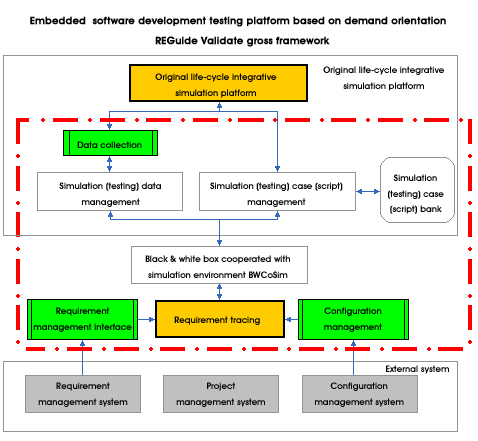CRESTS/REGuide ValidateThe Importance of demand orientationIn software simulation platform development/testing process, check whether demands are realized or not; find the faults that are not correspondent with each other between demands and realization codes-maybe demands are existing, but without source codes; or source codes are existing, but without correpondent demands. Two-way automatic tracing mechanism needs to be established between demands and source codes for validating high-consistency realization of demands.
In regression testing process, we are unaware of those testing cases need to be involved after amending source codes; in software alteration process, we are also unaware of those source codes need to be involved after the alteration of demands. And in error correction process, at the time of amending source code modules, we are still unaware of those demand realizations need to be involved. In brief, any alteration of demands or source codes may cause inconsistency faults between demands and source codes.
TargetEmbedded software development/testing platform CRESTS/REGuide Validate based on demand orientation, can validate that whether demands and source codes are coherent or not; realize two-way multilevel automatic tracing among source codes, testing cases and demands, that is, realize link automation, multilevel two-way mutual tracing automation and its updated automation between demand specification & various corresponding files and source codes.
Support embedded environmentsREGuide Validate can provide abundant graphical browse function, and generate structural diagram, function call diagram and so on. And these structural diagrams can rapidly provide program structure to help users understand, test and maintain software systems of users.
Reflect GPS functionREGuide Validate can simplify code tracking by providing the functions of dynamic logic diagram and flow diagram, that makes easy for users to check codes and logic flow of tracking complex programs. This can greatly accelerate the comprehension for codes, and also can help to find logic faults in programs; displaying embedded code testing coverage and performance and meanwhile displaying unexecuted codes and routes.
Technical and functional features•establish dynamically mutual tracing ability among testing result and demand specification, testing cases, design files, source codes and so on; with the features of exactness, precision and automatic maintenance.
•point out unrealized demands.
•advoid blindness of regression testing after the amendment of source codes.
•point out useless source codes-without demands respond to them
•advoid unconsistency faults of software amendment.
•improve regression testing efficiency, up to ten times even higher efficiency.
•support CRESTS embedded software simulation platform
•support demand management and demand alteration management
•support configuration management and configuration alteration management
• System realization principle
Embedded software development/testing platform based on demand orientation can link by using dynamic running of testing scripts and CRESTS simulation platform, analyze mutual tracing relationship between testing cases and source codes, so to analyze and manage the consistency among software demands, testing demands, testing plans, testing cases, testing scripts and source codes, and also provide specific analysis result report.

As the above function diagram shown, the tracing among software demands, testing demands, testing cases and testing scripts can be realized to link through the way of text link. And the core is the tracing between testing cases and source codes. In this system, testing cases and source codes can be linked by adopting software dynamic execution as bridge.
Two-way tracing platform is the platform for managing two-way tracing of source codes & software demands, testing cases and testing scripts; it can complete forwardtracing from testing cases to source codes, and then complete backwardtracing to testing demands, testing scripts and software demands; also complete forwardtracing from source code modules to module code coverage and moreover have backward to testing cases, and then trace from testing cases to testing demands, testing scripts and software demands.